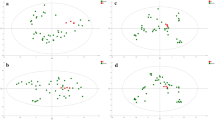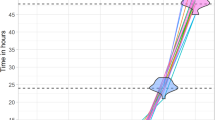Summary
Relationship between ATP changes of rabbit blood and postmortem interval (PMI) was studied. Twenty-four healthy rabbits were sacrificed and randomly divided into 3 groups with 8 rabbits of each group. The bodies of three groups were placed in calorstat at temperature of 15°C, 25°C and 35°C, respectively. The blood from the right ventricle was sampled through indwelling needle each 4 h until 72 h after death. ATP levels in the blood samples were measured by using ATP fluorescence rapid detection technique at different PMIs. Blood ATP levels slightly increased in the early stage after death and then constantly declined at all temperatures (15°C, 25°C, and 35°C). Cubic polynomial regression equations with log[ATP] as dependent variable (y) and PMI as independent variable (x) at different temperatures and the optimal time period were established as followed: Under 15°C and during 16–64 h after death, y=−3.027×10−5x3+0.003x2−0.096x-10.625 (R a 2=0.992, P<0.001); under 25°C and during 8–56 h after death, y=−2.921×10−5x3+0.002x2-0.059x-11.186 (R a 2=0.989, P<0.001); under 35dgC and during 4–36 h after death, y=−9.769×10−5x3+ 0.005x2-0.117x-11.166 (R a 2=0.991, P<0.001). The changes in ATP levels in blood collected from right ventricle of rabbit cadavers showed relatively stable and regular degradation within 72 h after death at different temperatures.
Similar content being viewed by others
References
Mecozzi M, Amici M, Visco G. Correction of the interference by mixing the reagents in the bioluminescent determination of ATP in environmental samples by an interfaced PC photometer and a robust regression procedure. Fresenius J Anal Chem, 1997,357(6):747–751
Moir DT, Ming Di, Opperman T, et al. A high-throughput, homogeneous, bioluminescent assay for Pseudomonas aeruginosa gyrase inhibitors and other DNA-damaging agents. J Biomol Screen, 2007,12(6):855–864
Frundzhyan V, Ugarova N. Bioluminescent assay of total bacterial contamination of drinking water. Luminescence, 2007,22(3):241–244
Aycicek H, Oguz U, Karci K. Comparison of results of ATP bioluminescence and traditional hygiene swabbing methods for the determination of surface cleanliness at a hospital kitchen. Int J Hyg Environ Health, 2006,209(2): 203–206
Mecozzi M, Acquistucci R. Computer assisted determination of ATP in environmental and food samples by bioluminescent assay: comparison of algorithms. Comput Methods Programs Biomed, 2000,62(1):35–43
Chen B, Li YH. The study on relationship between the postmortem interval and the change of ATP in brain tissue. J Forensic Med (Chinese), 1997,13(3):138–139
Huang A, Long R, Wang WP, et al. Study on the correlation between the postmortem interval and average ATP degradation of the skeletal muscle of thigh of rats after death. Am J Chin Clin Med, 2005,7(2):127–128, 131
Long R, Huang A, Wang WP, et al. Study on the correlation between the postmortem interval and the average ATP degradation of the skeletal muscle of thigh and liver of rats after death. Am J Chin Clin Med, 2005, 7(3):184–185,188
Vass AA. The elusive universal post-mortem interval formula. Forensic Sci Int, 2011,204(1–3):34–40
Forbes SL, Stuart BH, Dadour IR, et al. A preliminary investigation of the stages of adipocere formation. J Forensic Sci, 2004,49(3):566–574
Forbes SL, Stuart BH, Dadour IR. The effect of the burial environment on adipocere formation. Forensic Sci Int, 2005,154(1):24–34
Megyesi MS, Nawrocki SP, Haskell NH. Using accumulated degree-days to estimate the postmortem interval from decomposed human remains. J Forensic Sci, 2005, 50(3):618–626
Bisegna P, Henssge C, Althaus L, et al. Estimation of the time since death: sudden increase of ambient temperature. Forensic Sci Int, 2008,176(2–3):196–199
Henssge C, Madea B. Estimation of the time since death in the early post-mortem period. Forensic Sci Int, 2004,144(2–3):167–175
Xiao XH, Wei SZ, Huang SD, et al. Effect of different anticoagulant on red cell osmotic fragility test. Lab Med Clin, 2009,6(12):966, 968
Kang SX, Zhang H, Zhang ML. Comparative analysis of serum and heparinized plasma samples for measurement of routine chemistry tests. Chin J Gen Pract (Chinese). 2008,6(10):1081–1082
Freise KJ, Schmidt RL, Gingerich EL, et al. The effect of anticoagulant, storage temperature and dilution on cord blood hematology parameters over time. Int J Lab Hematol, 2009,31(5):496–504
Author information
Authors and Affiliations
Corresponding author
Additional information
These authors contributed equally to this work.
This project was supported by the National Natural Science Foundation of China (No. 81072505).
Rights and permissions
About this article
Cite this article
Sun, Ty., Zhang, Hd., Yang, Tt. et al. Changes in ATP levels in rabbit blood and its application for estimation of the postmortem interval. J. Huazhong Univ. Sci. Technol. [Med. Sci.] 33, 452–456 (2013). https://doi.org/10.1007/s11596-013-1141-8
Received:
Published:
Issue Date:
DOI: https://doi.org/10.1007/s11596-013-1141-8




